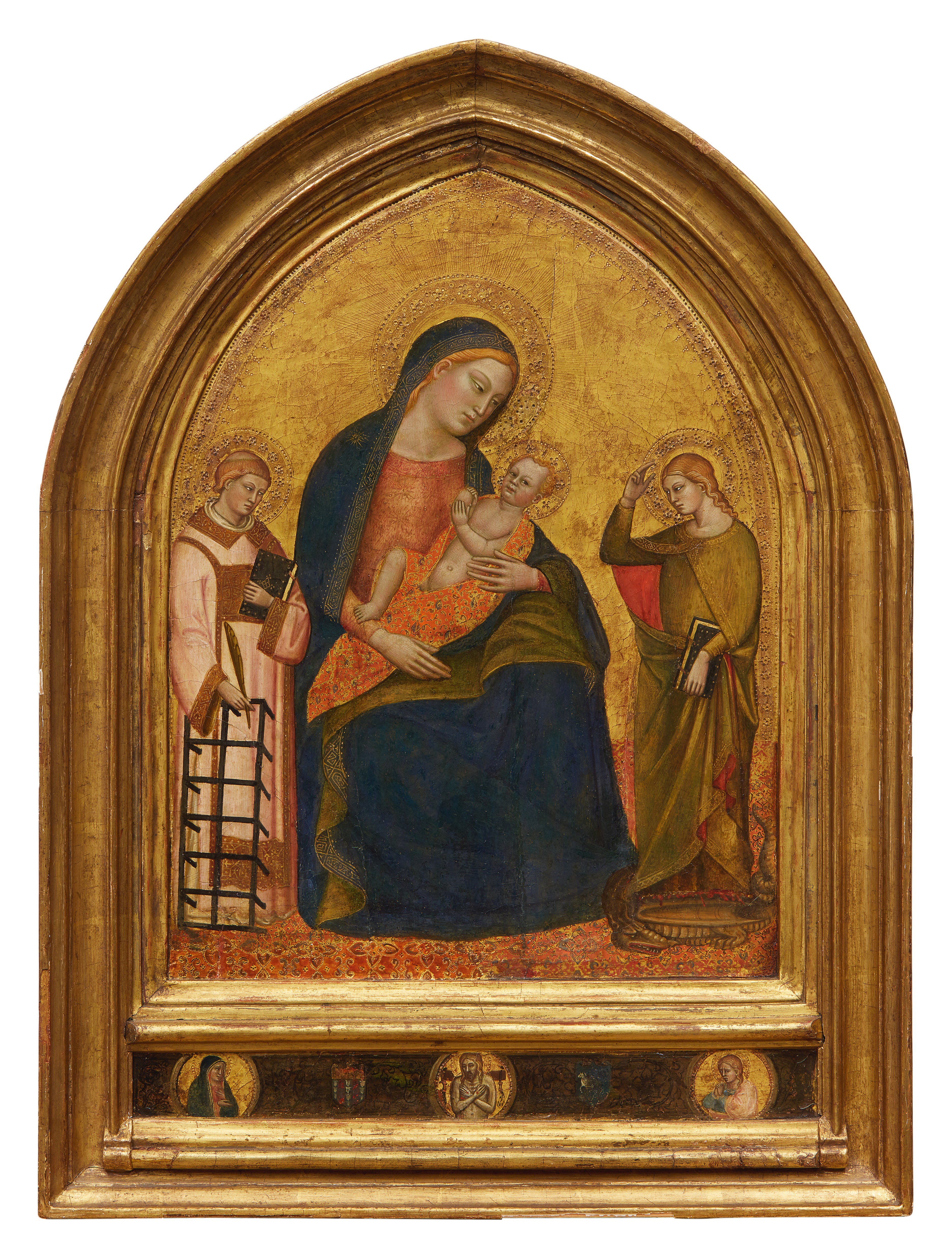
This small altarpiece is an exceptionally beautiful work by Jacopo di Cione, who was active in Florence in the second half of the fourteenth century. The Virgin Mary nursing the Christ child accompanied by saints was an important religious subject in early Renaissance Italy, and the pose of the Virgin in the present work represents a specifically Florentine invention. Stylistically, the main panel of the painting can be dated to c. 1380, while the predella is a later addition by an unknown hand. Because of this, the coats of arms on the predella, probably belonging to the Bonciani and Pollia families, are not original to the painting above, and therefore the circumstances of its commission are unknown.
Jacopo di Cione’s exact life dates are uncertain, but he was probably born around 1340 and was documented in Florence in 1365 and registered with the Florence Physician’s Guild, to which painters belonged, in 1369. Jacopo came from a family of artists: his brother Andrea di Cione, called Orcagna, was the most important Florentine painter, sculptor and architect of the trecento. Jacopo and his brothers Nardo and Matteo assisted Andrea and Jacopo took over the workshop after Andrea’s death in 1368. Many of the paintings produced in Orcagna’s workshop in the 1370s and 1380s are collaborative works involving at least two hands, including that of the anonymous Master of the Ashmolean Museum Predella. Though this painting was attributed to the latter artist when it was at auction in 1988, scholarly opinion largely favours an attribution to Jacopo di Cione on the basis of style and quality.
Bernard Berenson first published the work as tentatively attributed to Jacopo di Cione and dated to c. 1375, an attribution which was supported by Miklos Boskovits’ later suggestion that Jacopo was responsible for the design. Richard Offner attributed the painting to the Master of the Vatican Coronation, which is an earlier pseudonym for the same anonymous hand now called the Master of the Ashmolean Predella, whose oeuvre is not universally agreed upon. More recently, Boskovits and Mina Gregori suggested that the Virgin and Child were by Jacopo while the lateral saints may have been designed by Jacopo and executed by the anonymous master. Given the collaborative nature of the workshop, it is possible that some aspects of execution were left to the Master of the Ashmolean Predella, to whom Sonia Chiodo believes the entire work can be attributed (written communication, 2020). Laurence Kanter, however, argues that Jacopo is the best attribution for the entire central panel due to its high quality (written communication, 2020).
The panel exemplifies the post-Giottesque style of the late Florentine trecento, with the hieratic scale emphasising the Virgin over the companion saints, and the pose of the Virgin and Child a combination of the Madonna of Humility and Madonna Enthroned. The patterned mantle of the Christ child points to the luxury textile trade in Florence and he appears partially nude, reflecting a trend developing in the Orcagna workshop throughout the second half of the fourteenth century. Both the partial nudity of the infant Christ and the motif of his mother nursing him underscore the humanity of the Holy Family, and Mary’s role as the mother and nurturer of the Church. At left, Saint Lawrence, patron saint of Florence, is attired in a deacon’s dalmatic and tonsure and holds a Gospel as well as the gridiron on which he was martyred. Opposite, Saint Margaret emerges from the dragon wearing green robes and gesturing toward her head, likely a reminder that she was beheaded as well as a gesture of respect toward Christ. As patron saint of childbirth, Margaret may have been included because the original commission commemorated a birth in the patron’s family.
The predella of the present painting is a later addition by another artist and may date as late as the early fifteenth century. It depicts Christ as the Man of Sorrows in the central roundel with the Arma Christi (instruments of the Passion) behind him, flanked on the left by the Mater Dolorosa and on the right by a mourning John the Evangelist. The combination of these three figures in a predella is a typical motif in the trecento and early quattrocento. The coats of arms between the three figures were identified by Jessie McNab of the Metropolitan Museum of Art in 1991 as most likely belonging to the Bonciani (left) and Pollia (right) families. The former family’s arms bear a gold chief with a red and silver ground with black fur, and the latter’s are a pegasus on a blue ground. Both families originated in France, and the Pollia likely migrated to Florence from Brest. The Bonciani had a family chapel in Santi Apostoli, where Jacopo di Cione painted a large altarpiece in collaboration with Niccolò di Pietro Gerini in 1383. Unfortunately there appears to be no archival evidence connecting these families to the present painting, and as the predella is an addition, their ownership does not in any case explain the commission of this exquisite trecento devotional work.